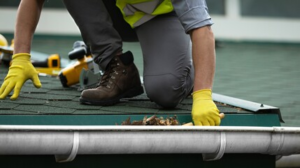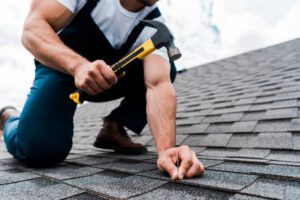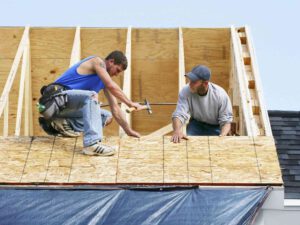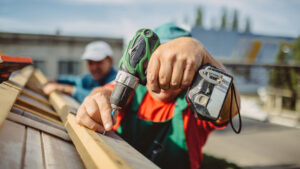Your roof is a barrier between your family and the elements. It protects your possessions from obvious hazards such as falling tree limbs and less-obvious ones like leaks that can cause mold and mildew.
K2T Roofing helps extend the life of your roof, reducing the likelihood of an early replacement. Routine inspections also allow for fixing small problems before they become major leaks.

Gutters and downspouts are essential to protect a home’s roof. They collect rain and divert it away from the foundation, which reduces the chances of water getting into the basement or crawl space (EPA Indoor airPLUS). If a gutter is clogged or not working, it may cause rainwater to overflow onto the roof. This can damage shingles and lead to the formation of mold or mildew. Gutters and downspouts should be cleaned regularly to ensure they function properly. A properly functioning system can save a lot of money and trouble in the long run.
Gutter clogs often occur in the spring when trees start to bloom and in the fall when leaves are falling. Over time, the debris that accumulates can block the openings of the gutter and downspout. This isn’t just an inconvenience; a clogged or blocked gutter can cause serious water problems to the roof, walls and interior of the home.
A clogged gutter can also damage your foundation and the siding of your house. Water that backs up under the siding can leak into the house and cause wood rot and other issues. In addition, water can leak between the shingles and cause roof shingle erosion. As a result, the shingles are weakened and may need to be replaced.
It is recommended that homeowners clean their gutters and downspouts at least twice a year, once in the spring before heavy rains and once in the fall to prevent ice dams in the winter. This requires climbing on a ladder, so it is important to use good safety practices when doing so, including securing the ladder and making sure it is on stable ground.
In addition to cleaning the gutters, it is a good idea to trim any tree branches that hang over or near your house. If the limbs are too close, they can damage your roof and potentially fall onto the house. Additionally, if the limbs are overgrown, they can rub against your roof and create dents in it, as well as block your downspouts. In addition, overhanging limbs can introduce pests and animals into the home, which can lead to further issues.
Probably the biggest non-weather-related threat to a roof is trees that grow too close and endanger the structure of the house. A fallen tree branch can easily damage shingles and even puncture the roof deck. Keeping branches trimmed and away from the house and gutters prevents this, while also making your home look better. In addition, trimming a dense canopy of branches allows sunlight to reach the ground and increases air flow, both of which reduce the risk of bugs, fungi and disease infecting the rest of the tree and surrounding plants.
Start by removing any dead, dying or damaged limbs, then thin the canopy, concentrating on branches growing near the roof area (crown thinning). This will help to keep them from falling and damaging the shingles or the surrounding yard. Thinner crowns are healthier, more attractive, and more resistant to storm damage.
When pruning a mature tree, be sure to use a sharp tool and to make the cuts in a way that will not damage or tear the bark. For example, when removing a large branch, use a pair of hand shears instead of a chainsaw to avoid damaging the bark or creating a wound that can allow fungus to enter and kill the trunk. When using shears, cut into the underside of the branch first and then into the top side, aligning the second cut with the first one. This will prevent the branch from tearing away from the trunk.
Prune shrubs that bloom on old wood in late spring or early summer, such as azaleas, beautybush, bee-balancers, clematis, lilacs, mountain laurel, nandina, phlox, rhododendrons, viburnums, sweetspire, and weigela, after their flowers fade. This will keep them from putting out new growth that could potentially choke out the healthy buds that would have otherwise opened this year.
Never “top” a tree, which is the indiscriminate cutting of branches to a height that exposes them to breakage, wind, crop loads, insects and diseases. This practice can lead to short life spans and pose a safety hazard for people and property.
A professional roof maintenance inspection will include a thorough look at the flashing. These are strips of metal (lead, aluminum, galvanized steel, or copper) that are placed along the edges of a roof and at any joints. They help to divert water and keep it out of areas that shingles cannot, such as around chimneys, skylights, vent pipes, and dormers. Flashing is prone to corrosion over time and can also be damaged by physical damage. If a portion of flashing is no longer working correctly, it can open up the roof to infiltration and lead to costly repair work.
Typically, flashing is caulked in place, so any areas of deterioration should be examined and resealed to encourage its proper functioning. A roofer will also look at the penetration seals on roof-mounted equipment such as ductwork, drains, and media installations to make sure that they are intact. They will also look at moss and other debris that may be growing on the roof to determine if it is causing material decay underneath the shingles.
Most of the time, water leaks are caused by issues with the flashing, which is why this should be inspected regularly. It can be a challenge to spot problems with your flashing from the ground, so you will need to either climb up on the ladder or crawl into the attic.
If you choose to climb on the roof, it is important that you wear rubber-soled shoes and use a sturdy ladder. A good quality ladder should be long enough to allow you to reach the roof and inspect the flashings without straining your back or neck. If you are not comfortable navigating the ladder and examining your roof from the ground, it is recommended that you have a professional roof maintenance inspection done to avoid any potential injuries. A reputable roofing company can perform a thorough roof maintenance inspection and will be able to identify any areas that need attention. Taking prompt action to fix these minor issues will prevent further damage and save you money in the long run.
Many homes are built with an attic or crawl space above the home. These spaces are sometimes used for storage but are important to inspect regularly for any problems. Leaks are the most common issue that can occur in these areas and it’s usually the attic that is the first place a leak will show itself so checking regularly is key to keeping your home safe from water damage.
Crawl spaces and attics are often overlooked because they can be hard to access and can be dangerous to enter without proper equipment. However, they are an essential part of a home and should be inspected at least annually for many reasons.
A well-maintained attic or crawl space will help to regulate a home’s temperature, reduce energy costs, and keep unwanted pests out. In addition, it’s a great area to install insulation, which helps keep the heat from the sun from seeping into the home in the summer and keeps warm air in during the winter.
Inspecting the attic or crawl space is also a great way to spot potential electrical issues before they become larger concerns. If there are exposed wires in the attic or crawl space, it’s important to have a professional electrician look at them to ensure that they are in good condition. In addition, if there are signs of a rodent or pest infestation, it’s important to have a professional exterminator take care of them as soon as possible.
If there is mold in the attic or crawl space, it’s essential to have it cleaned right away. Mold spores can be extremely dangerous to people who breathe them in and can cause breathing problems and even asthma attacks. Additionally, mold can cause wood rot, which can eventually compromise the structural integrity of the house.
Lastly, if there’s any visible evidence of a roof leak, it’s best to have a professional roofing company come out and take a closer look at it. A professional will be able to identify the source of the leak and make any repairs necessary to prevent further damage to your home.



